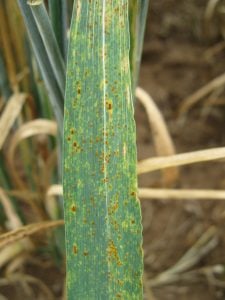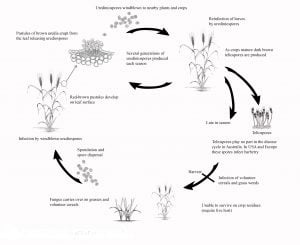Compared to stripe and stem rust, leaf rust is potentially the least damaging in susceptible varieties, but in most seasons, conditions are conducive for this disease to develop. In Victoria, severe leaf rust infections can reduce grain yield by more than 20 per cent in susceptible varieties and can also reduce grain quality. Leaf rust is effectively controlled when resistant varieties are grown, but when susceptible varieties are grown protection with fungicides may also be required.
Recent detections of new pathotypes of leaf rust means that many important cultivars have poor levels of resistance to leaf rust.
What to Look For
Leaf rust is a relatively easy disease to diagnose as it forms orange-brown pustules that are raised above the leaf surface. These pustules can be rubbed off the leaf leaving an orange-brown mark on the finger. The pustules which are scattered across the leaf surface are circular to oval in shape and confined chiefly to the upper surface of the leaf.
Later in the season, black teliospores develop on mature plants, usually on the under surface of the leaf or on the leaf sheath. These black spores are not of concern.
Disease Cycle
Leaf rust is caused by the fungus Puccinia triticina (formally Puccinia recondita). Leaf rust, like other cereal rusts, requires a living host to survive from one season to the next.
The most important hosts for leaf rust are susceptible volunteer wheat plants growing during the summer/autumn. Rust cannot carry over from one season to the next on seed, stubble or soil.
Wheat varieties susceptible to leaf rust enable inoculum levels to build up on volunteers during the summer and autumn. This can be a problem in seasons following wet summers that favour the growth of self-sown wheat. The plants that become heavily infected with rust in the autumn provide a source of rust for the new season’s wheat crop. If these conditions are followed by a mild winter and a warm wet spring, then the chances of a leaf rust epidemic are high. Therefore, the chances of a rust epidemic are greatest following a wet summer.
In Australia, due to the absence of an alternate host, leaf rust can only reproduce asexually. This reduces the genetic variability within the leaf rust population and therefore increases the likelihood that resistant varieties will be effective for a long period of time.
Rust spores are wind-blown and can be spread over large areas in a short time. The establishment of leaf rust epidemics within a crop is favoured by wet conditions and temperatures of approximately 15-22°C.
Leaf Rust Management
Resistant Varieties
The best way to manage leaf rust is to avoid susceptible varieties. When most wheat varieties are resistance long term control can be achieved.
However, leaf rust through chance mutation or exotic introduction can produce new races which are capable of attacking varieties that were resistant when they were first released. Widespread cultivation of resistant varieties minimises the levels of rust in the environment and reduces the occurrence of new races.
It is important that growers are aware of their varieties’ disease resistance to leaf rust. Variety resistance ratings are available in the Victorian Cereal Disease Guide (AG 1160) and on the NVT website. It is important to use a current disease guide as mutations occur in rust from time to time and resistant ratings are adjusted accordingly.
Foliar Fungicides
There are many foliar fungicides registered for the control of leaf rust in wheat. Fungicides should not be regarded as a substitute for growing resistant varieties. They are more of a backup for when a new race of rust evolves and for use in regions where adequate resistance is not available. A fungicide response is unlikely in resistant (R) or moderately resistant (MR) rated varieties.
Like the other rusts it is important to apply fungicides early in the epidemic. If a severe epidemic develops early in the season in a susceptible variety then it may be necessary to make two applications of fungicide. Leaf rust first appearing after ear emergence is less likely to have a significant impact on grain yield.
Seed Treatments
There are seed treatments available which will suppress early infections of leaf rust. Seed treatments are important in susceptible varieties, especially if they are sown early or following a wet summer favouring growth of volunteers.
Cultural Practices
Heavy grazing, or the use of herbicides, during autumn to remove self-sown susceptible wheat (the green bridge) will reduce the amount of rust in following crops. However, if spring conditions are favourable for leaf rust development, then even small amounts of rust that survived the autumn can multiply to cause serious yield losses in the spring.
Leaf Rust Pathotype Monitoring
The Australian Cereal Rust Control Program, based at the University of Sydney and supported by the GRDC, conducts annual monitoring of cereal rust pathotypes (strains) present in Australia. The information on the pathotypes present in Australia is crucial in determining how varieties will perform to the dominant rusts present in Australia. Details on how to submit rust samples for pathotyping and to view pathotyping results see Further Information.
Please note: This book is also available on AppleBooks




